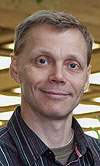Exploring the nonlinear world of accelerators
 |
|
Sergei Nagaitsev
|
Sergei Nagaitsev, associate head of the Accelerator Division, wrote this week's column.
"Physics would be dull and life most unfulfilling if all physical phenomena around us were linear. Fortunately, we are living in a nonlinear world. While linearization beautifies physics, nonlinearity provides excitement in physics." - Y. R. Shen, The Principles of Nonlinear Optics
Accelerator scientists at Fermilab plan to build a 30-meter-circumference accelerator to investigate an area of research known as nonlinear accelerator optics, founded nearly 50 years ago by the director of the Lawrence Berkeley National Laboratory, Edwin McMillan. This propsoed accelerator, an electron storage ring, will be built in the new accelerator test area in the NML building and will receive beam from the Advanced Superconducting Test Accelerator, under construction in the same building.
To guide particles around a ring, almost all accelerators in operation today rely on linear accelerator optics: they use magnets with two and four magnetic poles that surround the beam to steer and focus the particles. If the particles stray from the centerline, these dipole and quadrupole magnets force them back.
In the 1960s, scientists realized that adding nonlinear focusing magnets, which have at least six magnetic poles, could be beneficial for operating accelerators. But they found that adding nonlinear focusing to an accelerator could inevitably result in a loss of particles as nonlinear focusing magnets, if applied improperly, make particles behave chaotically.
Recent advances in solving the equations governing nonlinear accelerator optics have made the use of nonlinear focusing magnets a promising area of research. Several weeks ago, Fermilab held a one-day review on its novel, proposed test electron storage ring. We will use this ring, called the Integrable Optics Test Accelerator, to test ideas on how to construct an accelerator with strong nonlinear focusing while avoiding resonances and chaotic particle motion.
The IOTA ring review, chaired by Prof. Andrei Seryi of University of Oxford, highlighted the possible applicability of nonlinear systems to future colliders and high-intensity machines. The committee found that the IOTA project fits well with both Fermilab's mid-term vision aimed at the Intensity Frontier and advanced accelerator R&D as well as with our long-term vision.
The experimental program at IOTA will not be limited to the studies of nonlinear systems. The ring will also become a significant element of the Fermilab Advanced Accelerator R&D program by providing the foundation for carrying out exciting experiments and educating the new generation of accelerator physicists to support Fermilab's leadership in the field of accelerators.
Editor's note: Viatcheslav Danilov, Oak Ridge National Laboratory, and Sergei Nagaitsev published a paper on nonlinear accelerator optics in 2010. It was named one of the top six outstanding Accelerators and Beams papers by Physical Review editors that year.
|